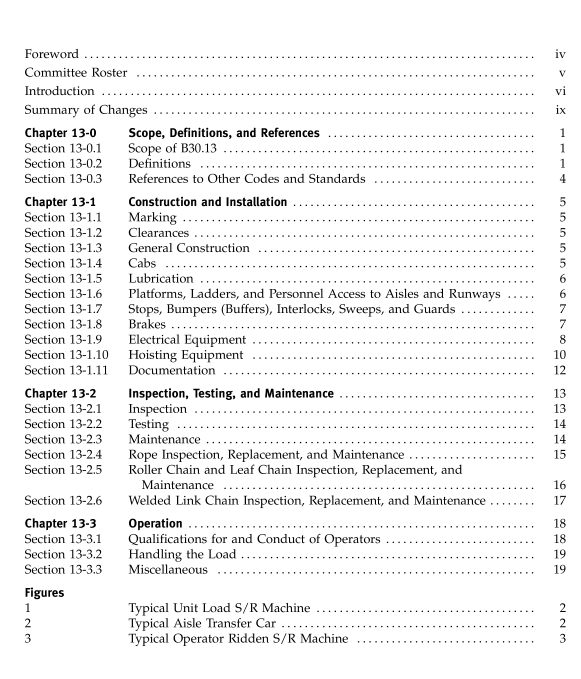ASME B30-13 pdf download

ASME B30-13 pdf download STORAGE/RETRIEVAL (S/R)MACHINES AND ASSOCIATED EQUIPMENT
SECTION 13-1.9: ELECTRICAL EQUIPMENT
13-1.9.1 General
(a) The provisions of this Section shall only apply to S/R machines, aisle transfer cars, and any load handling equipment which is part of or attached to S/R machines or aisle transfer cars. (b) If resistor enclosures are provided, they shall be installed to prevent the accumulation of combustible matter.
(c) Wiring Outside of Control Enclosures on an S/R Machine or Aisle Transfer Car
(1) Conductors external to control cabinets shall be enclosed in raceways or be protected cable, such as but not limited to types ALS, CS, or MI cable, subject to the exception that contact conductors, which are fully insulated except as necessary to provide access for col- lector shoes, may be used to service moving portions of such machines.
(2) Rubber, thermoplastic, or synthetic polymer insulation may be used in accordance with Table 310- 2(a) of ANSI/NFPA 70.
(3) The allowable ampacities of conductors shall be as shown in ANSI/NFPA 70, Table 610-14(a). For the ampacities of conductors between controllers and resis- tors, see ANSI/NFPA 70, Section 430-23. The ampacities of conductors within flexible cords or cables shall be in accordance with ANSI/NFPA 70, Article 400.
(4) Individual conductors run in conduits and race- ways or within jacketed multiple conductor wire shall not be smaller than No. 16.
(5) Flexible cords or cables which are part of special sensors or appliances and that conform to Articles 400 and 725 of ANSI/NFPA 70 may be used in short runs outside conduits or raceways.
(d) Wiring Within Control Enclosures
(1) When an S/R machine carriage is operator rid- den, the wiring shall be flame-retardant and moisture- resistant, and panel wiring to the main circuit resistors shall be suitable for a temperature of not less than 194°F (90°C).
(2) The allowable ampacity of conductors shall be as shown in ANSI/NFPA 70, Table 610-14(a), except for low energypower, low voltage power, and signal circuits conforming with the definitions and classifications of Article 725 of ANSI/NFPA 70.
(3) Minimum Conductor Size (a) Wiringotherthanlowenergypower,low volt- age power, and signal circuits conforming with the defi- nitions and classifications of Article 725 of ANSI/NFPA 70 shall not be smaller than No. 16.(b) Low energy power, low voltage power, and signal circuits may use any size wire consistent with the classification and limitations of Article 725 of ANSI/ NFPA 70.
(e) Traveling cables used as flexible connections between the S/R machine carriage and the S/R machine main frame shall be of the types of cable listed for this service in ANSI/NFPA 70.
(1) Traveling cables shall be so suspended at the carriage and S/R machine frame end as to reduce the strain on the individual conductors. Cables with an unsupported length exceeding 100 ft (30 m) shall have supporting fillers and shall be suspended directly by the supporting fillers. Where nonmetallic fillers are used, the cables shall be suspended byloopingthe cables around the supports, or shall be suspended from the support by a means that automatically tightens around the cable when tension is increased.
(2) In hazardous locations, traveling cables shall be of a type designed for hazardous locations and shall be secured to explosion-proof cabinets as provided in Section 501-11 of ANSI/NFPA 70.
(3) Traveling cable supports shall be so located as to reduce the possibility of damage due to the cables coming in contact with fixed structures or loads within their area of possible movement. Where necessary, guards shall be provided to protect the cables against damage.
(f) Contact Conductor Installation
(1) The open access for collector shoes should be facing to the side or downward to minimize the chance either of contamination or of contact with metal objects.
(2) Collector shoes shall be either guarded or located in such a way that inadvertent contact with adja- cent, exposed, and energized shoes is prevented, even when traversing a gap.
(3) Adjacent sections of conductor bar which are energized from separate power sources shall be sepa- rately protected and isolated.
(4) Collectors should be so constructed as to reduce to a minimum sparking between them and the contact conductors. When operated in rooms used for storage of combustible materials, the requirements of ANSI/ NFPA 70, Section 503-13 shall apply.









